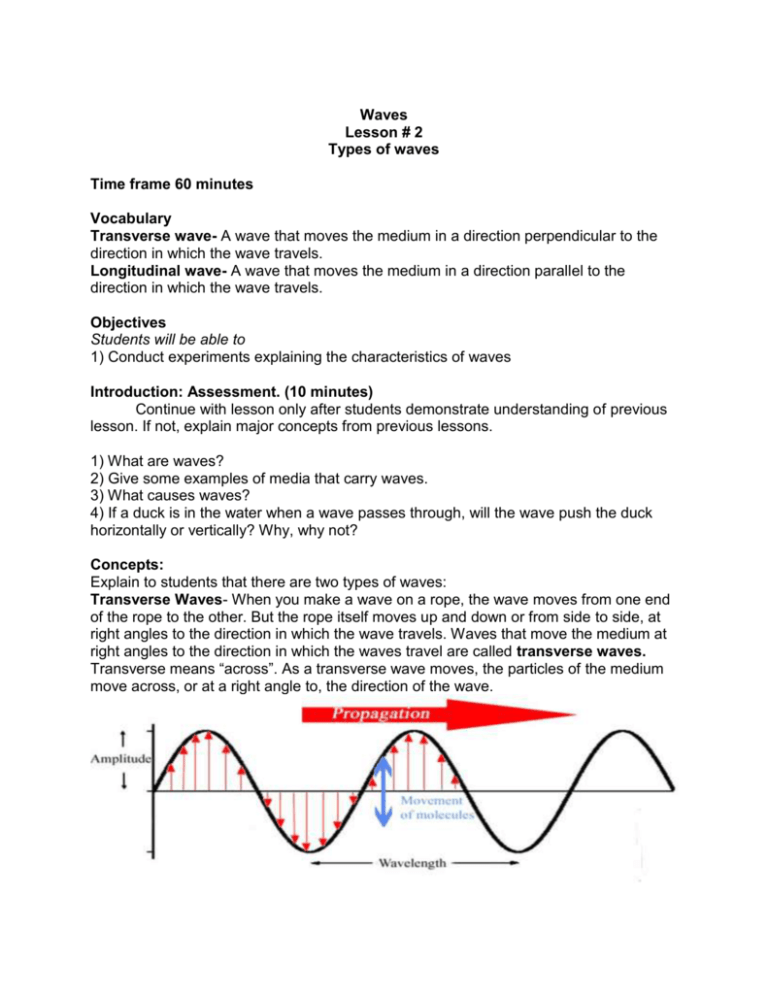Waves Lesson # 2 Types of waves Time frame 60 minutes
advertisement

Waves Lesson # 2 Types of waves Time frame 60 minutes Vocabulary Transverse wave- A wave that moves the medium in a direction perpendicular to the direction in which the wave travels. Longitudinal wave- A wave that moves the medium in a direction parallel to the direction in which the wave travels. Objectives Students will be able to 1) Conduct experiments explaining the characteristics of waves Introduction: Assessment. (10 minutes) Continue with lesson only after students demonstrate understanding of previous lesson. If not, explain major concepts from previous lessons. 1) What are waves? 2) Give some examples of media that carry waves. 3) What causes waves? 4) If a duck is in the water when a wave passes through, will the wave push the duck horizontally or vertically? Why, why not? Concepts: Explain to students that there are two types of waves: Transverse Waves- When you make a wave on a rope, the wave moves from one end of the rope to the other. But the rope itself moves up and down or from side to side, at right angles to the direction in which the wave travels. Waves that move the medium at right angles to the direction in which the waves travel are called transverse waves. Transverse means “across”. As a transverse wave moves, the particles of the medium move across, or at a right angle to, the direction of the wave. Longitudinal Waves- If you stretch out a spring and push one end, you produce a longitudinal wave. Longitudinal waves move the medium parallel to the direction in which the waves travel. The coil in the spring move back and force parallel to the wave motion. Focus Activity Students will use a rope and slinky to demonstrate transverse and longitudinal waves. Station 1 Transverse Waves Materials: Rope, colored tape and iPad Instructions to students 1) Wrap a piece of tape around the rope in one location 2) Hold the rope at either end and make a wave 3) Have another student videotape the wave with the “video physics” application on the iPad 4) Using the App, map out the wave following by “targeting” the tape on the rope 5) View the results in graph form and see how the rope moved up and down, not side to side Station 2 Transverse Waves Materials: Slinky, colored tape and iPad Instructions to students 1) Wrap a tape anywhere on the slinky 2) Two students hold a slinky on the ground. Make sure they don’t over-stretch it 3) Now, move one end of the spring back and forth on the floor. Notice the shape that the slinky makes and draw a diagram of it in your notebook. 4) Have another student videotape the wave with the “video physics” application on the iPad 5) Using the App, map out the wave following by “targeting” the tape on the slinky 6) View the results in graph form and see how the slinky moved side to side, not up and down Station 3 2-3 students per iPad Using the app, “String” on the ipad, let students come up with different kinds of waves. Ask them to take screenshots of the pictures they are taking. Ask to observe whether they are producing transverse or longitudinal waves. Conclusion/Assessment Ask students about what kinds of waves move through different mediums. Are sound waves transverse wave longitudinal or transverse? What about waves in a liquids and solids?








